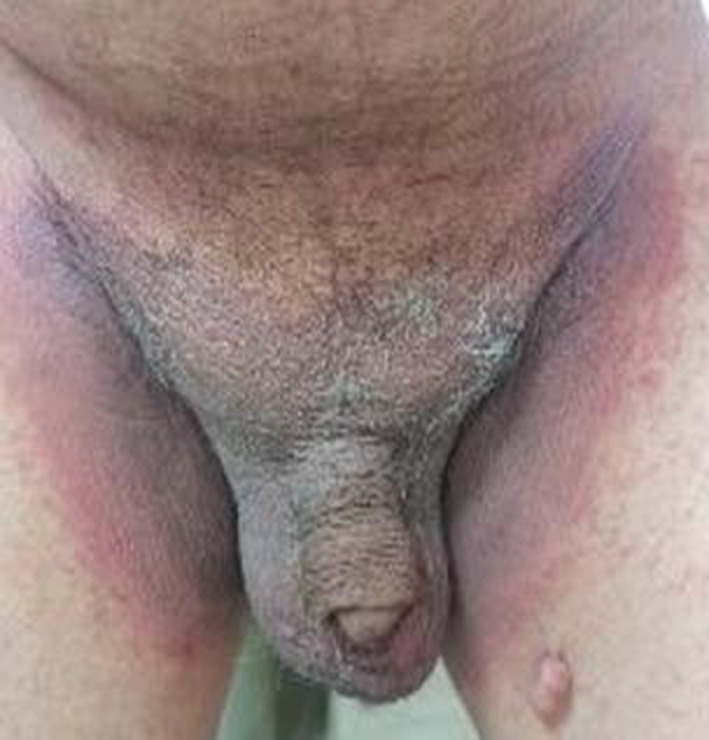Conflicts of interest
No conflict of interest.
Editor,
Systemic contact dermatitis is a condition seen in individuals when sensitized to an allergen through skin then exposure to the sensitized substance or cross‐reacting to it.1 In 1984, ‘Baboon syndrome’ described as a systemic contact dermatitis characterized with involvement of flexural region and buttocks area which named after the red bottomed baboons.2 Hausermann et al.3 reported drug‐related Baboon syndrome without a previous sensitization which named as symmetrical drug‐related intertriginous and flexural exanthema (SDRIFE). We are presenting a case of SDRIFE‐like eruption after COVID‐19 vaccination.
An 87 year‐old man presented to our clinic with itchy rashes which started from his arms then spread to his legs and genital area. The patient's history revealed that he had CoronoVac vaccine four days before the rashes. His medical history contains hypertension, coronary artery disease, chronic obstructive pulmonary disease and chronic kidney disease. The patient is using lercanidipine, theophylline, acetylsalicylic acid, tiotropium bromide and salmeterol for five years. Except his usual drugs, there was no use of new drugs or herbal products in his history. Dermatological examination revealed sharp boarded erythematosquamous plaques on the axillae, antecubital fossae, flexural areas of the forearms, inguinal folds and the anogenital area (Fig. 1). Laboratory tests were in normal range except elevated kidney levels. Skin biopsy showed epidermal parakeratosis, hyperkeratosis, acanthosis, spongiosis and mild lymphocyte exocytosis. Dermal changes include perivascular lymphohistiocytic infiltration and erythrocyte extravasation. With these clinical and histopathological findings, patient diagnosed with SDRIFE‐like eruption. For treatment, we started topical corticosteroids, oral antihistamine and 40 mg prednisolone which we tapered over a 3‐week period. Patient's lesions significantly recovered. The patient did not attend to his controls; therefore, we could not perform a patch test.
Figure 1.

Erythematous plaque with sharp borders in the genital area.
In December 2019, at Wuhan city of China, an unknown outbreak of severe lower respiratory disease was reported. SARS‐CoV2 isolated from these patients as causative agent and the disease named as COVID‐19. On March 11, 2020, the World Health Organization declared pandemic.4 By August 11, 2020, there were 19 936 210 cases and 732 499 deaths due to COVID‐19.5 Our patient had CoronoVac vaccine which is a SARS‐CoV‐2 purified, inactivated vaccine developed by SinoVac Biotech Corporation.4 CoronoVac vaccine contains inactivated SARS‐CoV‐2 antigen, aluminium hydroxide, disodium hydrogen phosphate, monosodium hydrogen phosphate, sodium chloride and sodium hydroxide.
Baboon syndrome can be caused by metals, drugs, plants and herbals. In our patient, there was no history of herbal use. He was using medications for his concomitant chronic diseases for 5 years. Most common causes for drug‐related baboon syndrome are antibiotics, 5‐aminosalicylic acid, oral corticosteroids, radiocontrast and monoclonal antibodies.6
There was no reported drug‐related Baboon syndrome due to the drugs the patient was using. Baboon syndrome also reported due to metals such as nickel, mercury, cobalt, chromium, zinc and gold. CoronoVac vaccine contains aluminium; however, there is no declared baboon syndrome related to aluminium in the literature. There are case reports of baboon syndrome due to thiomersal in vaccines.7 However, CoronoVac does not contain thiomersal. To our knowledge, there are no other reported SDRIFE‐like eruption related to vaccines. There are two reported cases of SDRIFE‐like rash with COVID‐19 infection. However, it has not been clearly revealed whether it is related to the drugs used to treat COVID‐19 or to COVID‐19 infection itself.8, 9
In this case report, we are presenting a case of SDRIFE‐like eruption due to COVID‐19 vaccine. On the other hand, we could not fully understand the culprit allergen that causes the eruption. As the number of people whom has been vaccinated increases, new cutaneous reactions due to COVID‐19 vaccines can be defined. Also the pathophysiology of skin reactions caused by COVID‐19 vaccine can be understood more clearly.
Acknowledgement
The patients in this manuscript have given written informed consent to the publication of their case details.
References
- 1.Jacob SE, Zapolanski T. Systemic contact dermatitis. Dermatitis 2008; 19: 9–15. [PubMed] [Google Scholar]
- 2.Andersen KE, Hjorth N, Menne T. The baboon syndrome: systemically‐induced allergic contact dermatitis. Contact Dermatitis 1984; 10: 97–100. [DOI] [PubMed] [Google Scholar]
- 3.Häusermann P, Harr T, Bircher AJ. Baboon syndrome resulting from systemic drugs: is there strife between SDRIFE and allergic contact dermatitis syndrome? Contact Dermatitis 2004; 51: 297–310. [DOI] [PubMed] [Google Scholar]
- 4.Rego GNA, Nucci MP, Alves AHet al. Current Clinical Trials Protocols and the Global Effort for Immunization against SARS‐CoV‐2. Vaccines (Basel) 2020; 8: 474. [DOI] [PMC free article] [PubMed] [Google Scholar]
- 5.WHO Coronavirus Disease (COVID‐19) Dashboard. URL https://covid19.who.int
- 6.Miyahara A, Kawashima H, Okubo Y, Hoshika A. A new proposal for a clinical‐oriented subclassification of baboon syndrome and a review of baboon syndrome. Asian Pac J Allergy Immunol 2011; 29: 150–160. [PubMed] [Google Scholar]
- 7.Zenarola P, Gimma A, Lomuto M. Systemic contact dermatitis from thimerosal. Contact Dermatitis 1995; 32: 107–108. [DOI] [PubMed] [Google Scholar]
- 8.Chicharro P, Rodríguez‐Jiménez P, Muñoz‐Aceituno E, De Argila D, Muñoz‐Hernández P, Llamas‐Velasco M. SDRIFE‐like rash associated with COVID‐19, clinicopathological correlation. Australas J Dermatol 2021; 62: 88–89. [DOI] [PMC free article] [PubMed] [Google Scholar]
- 9.Bevilaqua M, Ribolli GB, Luzzatto L, Fernandes JC, Pasqualotto AC, Bonamigo RR. SDRIFE‐like rash in COVID‐19 patient: drug reaction or another cutaneous manifestation of SARS‐CoV‐2? Int J Dermatol 2021; 60: 884–885. [DOI] [PMC free article] [PubMed] [Google Scholar]


